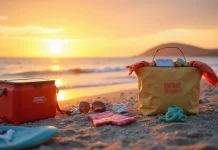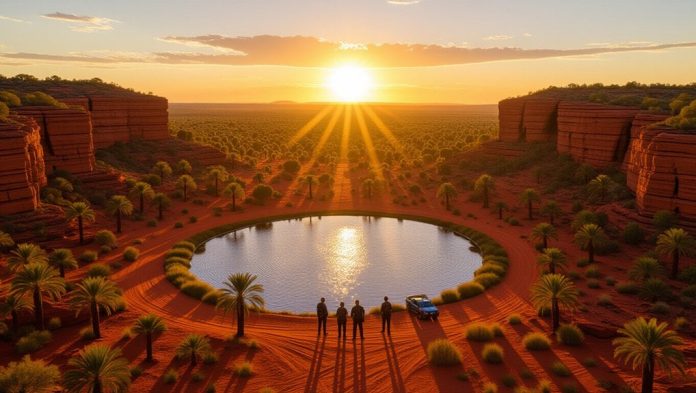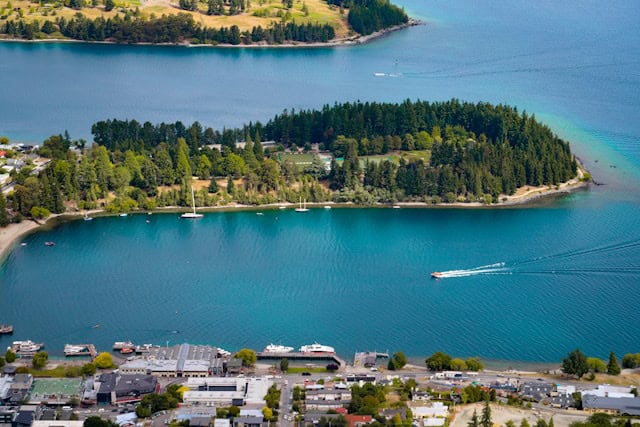Exploring Australia’s Wild Outback is an adventure, but preparation is essential. Pack an emergency survival kit and hydrate with at least 3 to 4 liters of water daily. Use portable filters and purification methods for safe drinking. Embrace mindfulness techniques to manage stress when traversing rugged terrains. Keep an eye out for hidden oases—they're crucial for hydration and wildlife. Now, imagine the thrill of uncovering these secrets as you journey through this breathtaking environment.
Key Takeaways
- Pack an emergency survival kit with essentials like water, first aid, and fire-starting tools for safety in the Outback.
- Identify and utilize hidden oases as vital hydration and rest stops during intense heat and long hikes.
- Familiarize yourself with the terrain and wildlife to enhance navigation and reduce anxiety while exploring.
- Stay hydrated by drinking small amounts frequently and using portable water filtration methods for safe drinking water.
- Practice mindfulness techniques and maintain communication with trusted contacts to manage emotions during wilderness adventures.
The Importance of Preparation for Outback Adventures
When you venture into the vast and unpredictable Australian Outback, preparation isn’t just a good idea—it’s essential for your survival.
Start with gear selection; make sure you pack an emergency survival kit containing basics like water, warmth, and shelter. A minimum of 3 to 4 liters of drinking water per person per day is crucial to stave off dehydration in the arid climate.
Prepare an emergency survival kit with essentials like water, warmth, and shelter to thrive in the harsh Outback environment.
Next, focus on route planning. Familiarize yourself with the terrain and potential wildlife encounters, which can help reduce panic if you get lost.
Set clear navigation strategies, and always inform a trusted friend about your travel details and expected return times. This simple step improves your safety and guarantees quicker rescue if needed.
Hydration Strategies for Harsh Environments
In the unforgiving Outback, knowing where to find water is just as vital as having it on hand.
You’ll want to time your hydration wisely and be prepared with emergency filtration options, ensuring you stay refreshed no matter the circumstances.
Let’s investigate how to navigate these fundamental hydration strategies for your survival in this arid expanse.
Water Sources Identification
Identifying water sources in the Australian Outback is essential for survival, especially in such a harsh and arid environment.
You can increase your chances of finding water by paying attention to specific indicators:
-
Follow animal tracks**: Animals often lead you to reliable water sources.
-
Look for moisture indicators**: Damp soil or lush vegetation suggests underground water.
-
Collect dew: Early mornings are perfect for gathering dew from plants, providing a small hydration boost.
Additionally, familiarize yourself with local flora, like pigface and water lily, which can store moisture.
Remember, always purify any water you collect by boiling or filtering to eliminate harmful bacteria and parasites.
Knowing these techniques can make a significant difference in your survival quest!
Hydration Timing Techniques
Remaining hydrated in the unyielding Australian Outback necessitates strategic timing and awareness.
To fend off dehydration, aim to drink larger quantities—about 250 ml at a time—focusing on ideal timing throughout the day. Set hydration reminders to drink regularly, even before thirst strikes, as dehydration can sneak up on you.
Room temperature water is your best friend; it absorbs quickly, unlike ice-cold water that drains your energy to warm up. Plan hydration breaks during physically demanding activities, ensuring you replenish fluids consistently.
Always carry extra water, accounting for unexpected challenges that may increase your needs. By mastering these hydration timing techniques, you’ll improve your survival chances in this unforgiving terrain.
Stay vigilant, and keep your body fueled!
Emergency Water Filtration
While exploring the rugged beauty of the Australian Outback, knowing how to filter and purify liquid from natural sources can mean the difference between life and death. Untreated water can harbor harmful contaminants, but several effective methods can guarantee your hydration:
-
Portable filter types like straw filters or pump filters can remove bacteria and sediments.
-
Boiling water for at least one minute is a simple yet powerful purification method, killing most pathogens.
-
Chemical purification tablets (like iodine or chlorine dioxide) offer a lightweight option for treating water when you're on the move.
Always carry extra water and familiarize yourself with local sources.
Being prepared with these filtration strategies will keep you safe and hydrated during your Outback adventures.
Managing Emotions in the Wild
When you find yourself in the vast expanse of the Outback, it's natural to feel a surge of fear or anxiety; however, acknowledging these emotions can be your first step toward managing them.
Effective emotion regulation begins by developing a clear navigation plan, which can greatly reduce panic and help you maintain composure if you get lost. Familiarizing yourself with potential routes and landmarks instills confidence, lowering emotional distress in uncertain situations.
Practicing mindfulness techniques, like deep breathing, grounds you and combats irrational thoughts during stressful moments.
Also, maintaining communication with a trusted friend before your journey provides emotional support, making you feel secure knowing someone’s aware of your plans.
Embracing these strategies can improve your wilderness coping skills, allowing you to face the challenges of the wild with a calmer mindset and a clearer focus on survival.
Communication and Safety Protocols

Before you set off on your Outback adventure, let someone close know your plans and when to expect you back.
This simple step can be a lifesaver if things go awry.
Plus, having a reliable signaling device on hand, like a whistle, guarantees you can call for help when you need it most.
Inform Trusted Contacts
Informing trusted contacts about your plans is vital for safety in the unpredictable terrain of Australia’s Outback. Before you set off, share your itinerary and make certain they’re ready for safety monitoring.
Here are some crucial points to discuss:
-
Itinerary Sharing: Provide your expected start and end times along with specific landmarks or waypoints.
-
Contingency Plans: Discuss what steps to take if you’re delayed or can’t be reached.
-
Regular Updates: Keep your contact informed of any changes in your plans throughout your journey.
Emergency Signaling Devices
In the vast and often unforgiving stretch of Australia’s Outback, having the right emergency signaling apparatus can be a lifesaver.
Vital tools like whistles can project your calls for help up to a mile, while reflective mirrors create flashes visible from several miles away, perfect for catching the attention of distant aircraft.
Personal locator beacons (PLBs) are indispensable, transmitting your GPS coordinates directly to emergency services, drastically improving your odds of rescue.
Flares can also signal distress but remember, their burn time is limited, so use them wisely.
Regular signal device maintenance is important; checking your equipment guarantees everything functions correctly when it matters most.
Stay prepared, as these distress signal types could mean the difference between life and death.
Essential Survival Gear for Outdoor Excursions
When venturing into the Australian Outback, packing vital survival gear can make all the difference between a thrilling adventure and a harrowing experience.
To guarantee you’re prepared, consider including these multi-tool necessities in your compact emergency survival kit:
-
A reliable water supply (at least one liter per person)
-
A first aid kit for unexpected injuries
-
Fire-starting equipment for warmth and cooking
Your survival gear should be lightweight and easily transportable, allowing quick access in emergencies.
Don't forget to include important tools like a compass and map for navigation.
Regularly check and refresh your kit, replacing expired items and verifying everything is in working order.
Discovering Hidden Oases in the Outback

After ensuring you’ve got your survival gear sorted, the Outback beckons with its hidden oases that transform the arid terrain into lush havens.
Picture yourself at Ellery Creek Big Hole or Palm Valley, where oasis ecosystems thrive amidst the dry environment. These essential habitats not only provide important water sources but also support a rich diversity of flora and fauna, perfect for your wildlife photography pursuits.
As temperatures soar above 40°C (104°F), these oases become significant rest stops to hydrate and cool down.
Take the scenic trails at Kings Canyon to uncover hidden water sources while enjoying breathtaking views. Remember, accessing these hidden gems may require traversing rugged terrains, so be prepared and aware of your surroundings.
Embrace the adventure and discover the beauty that lies within the Outback’s secret oases—each one a reflection of nature's resilience and allure.
Frequently Asked Questions
Did Wade and Lisa Survive the Outback?
Yes, Wade and Lisa survived the Outback. Their survival hinged on Wade’s careful planning and Lisa’s resilience during the intimidating experience.
They faced extreme conditions, but by staying calm and acknowledging their fears, they navigated the vast terrain. With enough supplies and a solid communication plan, they managed to find their way back.
Their adventure taught them the importance of preparation, mental strength, and trusting each other for support in challenging times.
Where Is Ricky Megee Now?
Ricky MeGee’s now a beacon of resilience, sharing his survival wisdom with the world.
He’s shifted into public speaking, engaging audiences with gripping tales of endurance and the importance of preparation.
His current projects focus on wilderness safety, emphasizing hydration and mental strength.
Each story he tells serves as a lantern, illuminating the path for adventurers and reminding them to respect the wild.
You’ll find him inspiring others across Australia, nurturing greater awareness.
Is Netflix Outback a True Story?
Yes, Netflix's "Outback" is inspired by true occurrences, highlighting real outback experiences.
The film dramatizes the harrowing journey of a young woman lost in Australia’s vast wilderness, showcasing the challenges she encounters.
While it takes creative liberties for entertainment, the Netflix portrayal captures the essence of survival—emphasizing mental resilience and the importance of preparation.
It’s a gripping reminder of how unpredictable and perilous the outback can be without the right abilities.
What Are the 7 Priorities of Wilderness Survival?
Did you know that you can survive only about three days without water?
In wilderness survival, the seven priorities are essential: maintain a positive mental attitude, master survival skills, construct adequate shelter, create fire, signal for help, source water, and find food.
Start with shelter construction to protect yourself from the elements, then focus on water sourcing to stay hydrated.
Conclusion
So, you thought the Outback was just a vast expanse of red dust and endless sky, huh? Well, beneath that rugged exterior lies a world of hidden oases and survival secrets waiting for you to uncover. With the right preparation and a sprinkle of luck, you’ll not only endure but flourish in this wild paradise. Just remember, it’s not the absence of Wi-Fi that’ll challenge you—it’s the scorching sun and those cheeky kangaroos you didn’t see coming!





























